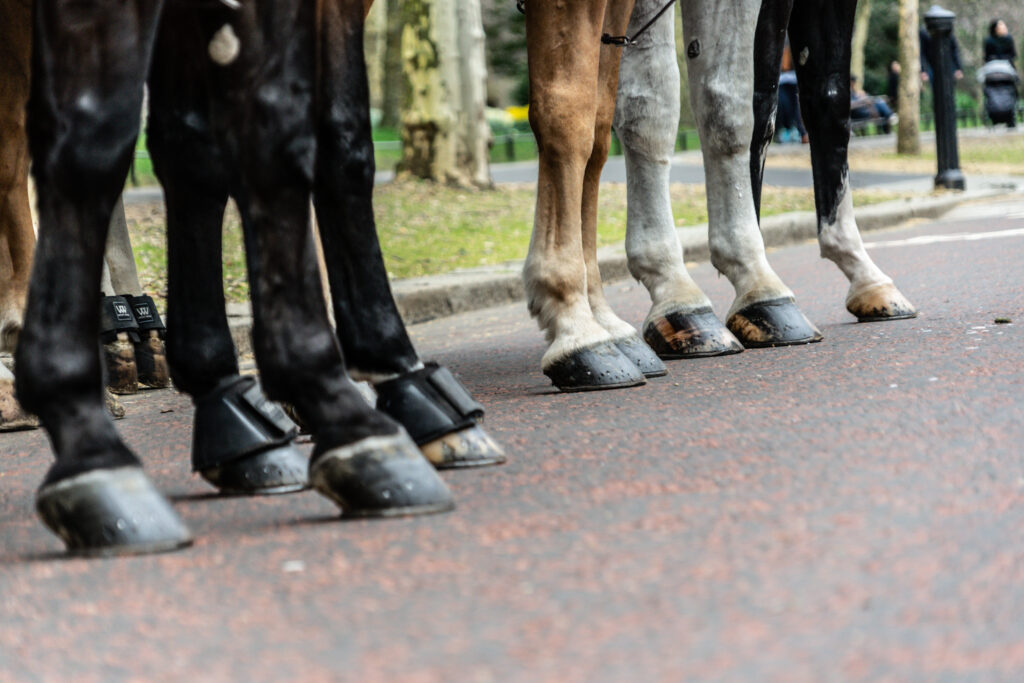Home > Horse Care > Hoof Care > Do hooves need trimming even if they don’t look long?
Do hooves need trimming even if they don’t look long?
- May 16, 2024
- ⎯ Editors of EQUUS
Question: I’ve always been told to have my horse’s hooves trimmed every six weeks, but I can’t help but think that’s an arbitrary rule. Sometimes his hooves look like they need attention before then, other times they look like they would be fine for a few weeks longer. Shouldn’t we be looking at the horse’s hooves to determine how often they need to be trimmed?
Answer: Do horses need to be on a routine hoof care schedule? The short answer is “yes.” Hoof walls grow at a relatively steady rate. There are variations based on the individual horse and season (typically faster in the summer and slower in the winter) but overall, the rate is consistent.

Hooves grow at a fairly steady rate, which makes keeping up with a regular farriery schedule important. (Getty Images)
An easy analogy is changing the oil in your car every 3,000-5,000 miles. Will your engine seize up and explode at 5,002 miles? Is there still some useful function in the oil at the end of this time? Is your car magically out of oil at that point? Couldn’t I have driven a few more days before paying for an oil change? Answers: probably not; probably yes; with some of the ranch trucks that I’ve driven over the years—most definitely; and as my 18-month-old son says, “yup.”
A regular farrier cycle
A regular farrier cycle is much the same. The range of every six to eight weeks is a safe and standard starting point. Sometimes it needs to be five-and-a-half weeks or nine weeks because of holidays or other conflicts—that is okay. Your 3,000 to 5,000 mile oil change sticker helps you avoid a 7,000 or 10,000 emergency oil change. In much the same way, a consistent and planned six- to eight-week schedule keeps it from becoming a 12- or 16-week emergency trim. By keeping your horse on a regular cycle, just like with regular oil changes, you are limiting excess stresses and strains from imbalanced feet and maximizing the performance and life of your horse’s feet and legs.
The hoof plays a vital role in both shock absorption and traction. Hoof pathologies and imbalances create problems throughout the leg. The worse the balance and health of the hoof, the more the leg and horse suffer. The goal is to maintain feet in good balance and optimal condition. From a structural standpoint, when a foot “looks long” you are already behind the curve! That sort of visible distortion indicates a breakdown in the strength and function of critical hoof structures. A good farrier and optimal cycle can minimize this.
How hooves look
Sometimes your horse’s feet may not look like they need a trim at the appointment. They may not be overtly overgrown and may, in fact, still be strong and balanced. This is a good thing and is literally what I want to see in my clients’ horses. Feet that still look good at the appointment are an indication that your horse has inherently good feet, good conformation, a good farrier, or some combination thereof. Obviously long feet indicate that damage (even if it is subtle) has occurred and unnecessary stress has been placed on structures that we try very hard to protect.
Booked schedules
Lastly, there’s a very important practical aspect to consider: Most farriers are booked well in advance. This means that it can be very difficult for you to get an appointment quickly. You might get lucky, but please don’t bet your horse’s well-being that you will. One way to find yourself constantly looking for a new farrier is to be the person calling for an “emergency” trim because your horse’s feet “suddenly” look long. Don’t wait until your horse’s feet look overgrown and then try to get an appointment. It’s far better to keep a quality farrier coming back by keeping your horse on an appropriate schedule. Then you can focus on enjoying your horse and worrying about all the other ways your horse likes to make life difficult.
Brian Eitelman, DVM, CJF
Aggie Vet and Farrier Services, LLC
Parker, Colorado
Our Expert: Brian Eitelman, DVM, CJF, is a graduate of Colorado State University. Prior to earning his Doctor of Veterinary Medicine degree, he attained the rank of Journeyman Farrier, the highest level of farrier certification. Brian is one of the only veterinarians in the United States to be an American Farriery Association-certified Journeyman Farrier.





